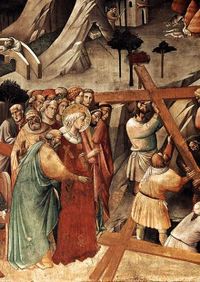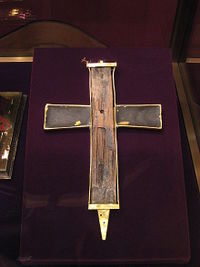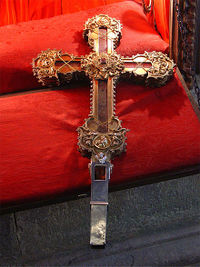Difference between revisions of "Category:Holy Cross (subject)"
| (14 intermediate revisions by the same user not shown) | |||
| Line 1: | Line 1: | ||
*[[ | [[File:1380 Gaddi.jpg|thumb|200px|The Finding of the Holy Cross by Helena, the mother of emperor Constantine, in 325 CE, in a painting by Agnolo Gaddi (1380)]] | ||
*[[Relics of Jesus|BACK to RELICS OF JESUS]] | |||
| Line 6: | Line 8: | ||
== Overview== | == Overview== | ||
According to a wide-spread narrative, Helena, the mother of Constantine, in 325 CE discovered three crosses buried near the [[Golgotha]]. The [[True Cross]] was identified as an ill person recovered at the touch of it. Along with the cross, [[Helena]] found the [[Holy Nails]] and the [[Titulus Crucis]]. All these relics (with the exception of the [[Holy Nails]] that Helena brought to | According to a wide-spread narrative, Helena, the mother of Constantine, in 325 CE discovered three crosses buried near the [[Golgotha]]. The [[True Cross]] was identified as an ill person recovered at the touch of it. Along with the cross, [[Helena]] found the [[Holy Nails]] and the [[Titulus Crucis]]. All these relics (with the exception of the [[Holy Nails]] that Helena brought to Constantinople) were displayed to the faithful in the Church of the Holy Sepulchre at Jerusalem until the Persian invasion in 615 CE. | ||
From this point on, the story of the Holy Cross is a complicated story of continuous losses and rediscoveries | From this point on, the story of the Holy Cross is a complicated story of continuous losses and miraculous rediscoveries. By the time of the First Crusade, the only thing that Arnulf Malecorne, the first Latin Patriarch of Jerusalem, could recover in Jerusalem was a small fragment of wood embedded in a golden cross. It became nonetheless the most sacred relic of the Latin Kingdom of Jerusalem, housed in the Church of Holy Sepulchre and paraded ahead of the army before every battle. In 1187 the relic was captured by Saladin during the Battle of Hattin and never recovered. | ||
====Legend of the Holy Cross==== | ====Legend of the Holy Cross==== | ||
Numerous legends developed in medieval Christianity about the building of the cross. | |||
At the center of Eastern traditions was the christological interpretation of Isaiah 60:13 ("The glory of Lebanon shall come unto thee, the fir tree, the pine tree, and the box [cypress] together to beautify the place of my sanctuary, and I will make the place of my feet glorious"). The cross (which is the glorious place where the feet of Jesus were nailed) was thus believed to have been made of cedar, pine and cypress. These are the holy trees of which the First and the Second Temple were also made, before the wood from these trees was removed with the Herod reconstruction and used for the making of the cross. | |||
In the West, by the 13th century, the story of the pre-Christian origins of the cross developed into an even more complex narrative, as attested in the ''Golden Legend'' by Jacopo de Voragine. The wood used to built Jesus' cross came from a tree planted by [[Seth]] on [[Adam]]'s grave. The tree lived until the time of [[Solomon]], who used its wood to built the bridge over which the [[Queen of Sheba]] passed. The wood was then buried for "fourteen generations" until it was used to make the cross. | |||
Despite the loss of the Jerusalem relict, fragments of the Holy Cross are said to be preserved in numerous locations. Especially after the sack of Constantinople in 1204, a flow of relics reached the West. At one point so many churches claimed to possess a piece of the True Cross, that [[John Calvin]] in his ''Traité des reliques'' is famously said to have remarked that there was enough wood in them to fill a ship. Today, the list of Churches and Monasteries who | ==== Fragments of the Holy Cross ==== | ||
[[File:True Cross Vienna.jpg|thumb|200px|Fragment of the Holy Cross (Vienna, Austria)]] | |||
[[File:True Cross Liébana.jpg|thumb|200px|Fragment of the Holy Cross (Liébana, Spain)]] | |||
Despite the loss of the Jerusalem relict, fragments of the Holy Cross are said to be preserved in numerous locations. Especially after the sack of Constantinople in 1204, a flow of relics reached the West. At one point so many churches claimed to possess a piece of the True Cross, that [[John Calvin]] in his ''Traité des reliques'' is famously said to have remarked that there was enough wood in them to fill a ship. Today, the list of Churches and Monasteries who preserve fragments of the Holy Cross includes: | |||
* The ''Koutloumousiou Monastery'' on Mount Athos [Greece] | * The ''Koutloumousiou Monastery'' on Mount Athos [Greece] | ||
* The ''Monastery of Santo Toribio de Liébana'' near Potes in Cantabria [Spain] -- The entire left arm of the True Cross is kept on a gilded silver reliquary. During the 8th century, the body of Saint Turibius of Astorga was moved to the monastery, along with the relic which he was believed to have brought from the Church of the Holy Sepulcher in Jerusalem for safekeeping. The Spanish sanctuary is still today one of the major centers of pilgrimage in Europe. | |||
* The ''Notre Dame Cathedral'', Paris [France] -- The relic was acquired by King Louis and formerly kept in the nearby Ste. Chapelle along with the [[Crown of Thorns]] and the (now lost) [[Holy Lance]]. After being housed in the Bibliotheque Nationale during the French Revolution, in 1806 the surviving relics were moved to the current location. | * The ''Notre Dame Cathedral'', Paris [France] -- The relic was acquired by King Louis and formerly kept in the nearby Ste. Chapelle along with the [[Crown of Thorns]] and the (now lost) [[Holy Lance]]. After being housed in the Bibliotheque Nationale during the French Revolution, in 1806 the surviving relics were moved to the current location. | ||
* The '' | * The ''Church of the Holy Cross in Jerusalem'', Rome, Italy -- The church houses one of the largest and oldest collections of [[Relics of Jesus]], which includes the [[Titulus Crucis]], the [[Holy Sponge]], one of the [[Holy Nails]], fragments of the [[Crown of Thorns]], etc. | ||
* The ''Holy Cross Abbey'', Tipperary, Ireland -- The relic was brought to Ireland by the Plantagenet Queen, Isabella of Angoulême, around 1233. It was last exposed for public veneration in 1632. Shortly afterward the Abbey was abandoned and felt in ruin, until it was restored as a national monument in 1866 and then partially reopen to worship in 1969. In the Fall 2011 the relict was reported to be stolen but then retrieved a few months later. A carbon analysis has recently revealed that this relict goes back to the 12th century. | |||
* The Cathedral of Ururi, near Campobasso, Molise [Italy] -- The presence of the relic is attested from the 18th century. | |||
* The | * The Basilica of Our Lady Help of Christians [Basilica di Maria Ausiliatrice], Turin [Italy] -- The relic is housed in the crypt. | ||
* | * Parrocchia dei Santi Nicolò e Giacomo, Capizzi, near Messina, Sicily [Italy] | ||
* | * Church of Sant'Antonio di Padova, Vasto, near Chieti, Abruzzo [Italy] -- The relic was presented to the now-demolished Church of San Pietro in Vasto in 1690 by Card Altieri. Moved to the actual location, in 1922 a new Chapel was built inside the Church of Sant'Antonio di Padova, to house the relic. | ||
* | * Acquaviva Collecroce (CB). | ||
* The '' | * Nonantola Abbey, near Modena [Italy] -- The reliquary of the Holy Cross is now displayed at the local ''Museo Benedettino e Diocesano di Arte Sacra''. | ||
* Church of San Francesco, in Pisa, Tuscany [Italy] -- It is said that the relic of the Holy Cross was brought to Pisa by St Bernardo of Chiaravalle. | |||
* [ | * Monastery of Cetinje [Montenegro] -- Legend says that fragments of the Holy Cross, along with the relic of the [[Relics of John the Baptist|Right Hand of John the Baptist]], came from Jerusalem, via Constantinople, to the hands of the Crusaders in Rhodes and then Malta. In 1799 the relics were presented to the Russian Czar Paul. The relics left St Petersburg [Russia] with the Russian revolution. After being preserved for some time in Copenhagen [Denmark], they were presented to the Serbian monarchy. Until 1941 they were in Belgrade [Serbia}, then in the monastery of Ostrog, then in the State Treasure, until they eventually ended in possession of the Serbian Orthodox monastery of Cetinje. | ||
* | * The ''Church of the Holy Cross'', Boston, MA -- The relic arrived in Boston in the late 18th century, a gift to a French missionary priest, the Rev. Jean-Louis Lefebvre de Cheverus, who later became the first bishop of Boston. In the Summer 2010 the relic was reported to be stolen and then recovered a few weeks later. | ||
* | * The ''Shrine of the True Cross'', Dickinson, TX -- The relic was brought here in 1936 from Rome, Italy. | ||
* The ''Monasterio de Tarlac'' in the Philippines -- The relic was brought here in 2005 from Germany. | |||
==External links== | ==External links== | ||
Latest revision as of 04:53, 5 September 2018
The Holy Cross is the cross used for the Crucifixion of Jesus.
Overview
According to a wide-spread narrative, Helena, the mother of Constantine, in 325 CE discovered three crosses buried near the Golgotha. The True Cross was identified as an ill person recovered at the touch of it. Along with the cross, Helena found the Holy Nails and the Titulus Crucis. All these relics (with the exception of the Holy Nails that Helena brought to Constantinople) were displayed to the faithful in the Church of the Holy Sepulchre at Jerusalem until the Persian invasion in 615 CE.
From this point on, the story of the Holy Cross is a complicated story of continuous losses and miraculous rediscoveries. By the time of the First Crusade, the only thing that Arnulf Malecorne, the first Latin Patriarch of Jerusalem, could recover in Jerusalem was a small fragment of wood embedded in a golden cross. It became nonetheless the most sacred relic of the Latin Kingdom of Jerusalem, housed in the Church of Holy Sepulchre and paraded ahead of the army before every battle. In 1187 the relic was captured by Saladin during the Battle of Hattin and never recovered.
Legend of the Holy Cross
Numerous legends developed in medieval Christianity about the building of the cross.
At the center of Eastern traditions was the christological interpretation of Isaiah 60:13 ("The glory of Lebanon shall come unto thee, the fir tree, the pine tree, and the box [cypress] together to beautify the place of my sanctuary, and I will make the place of my feet glorious"). The cross (which is the glorious place where the feet of Jesus were nailed) was thus believed to have been made of cedar, pine and cypress. These are the holy trees of which the First and the Second Temple were also made, before the wood from these trees was removed with the Herod reconstruction and used for the making of the cross.
In the West, by the 13th century, the story of the pre-Christian origins of the cross developed into an even more complex narrative, as attested in the Golden Legend by Jacopo de Voragine. The wood used to built Jesus' cross came from a tree planted by Seth on Adam's grave. The tree lived until the time of Solomon, who used its wood to built the bridge over which the Queen of Sheba passed. The wood was then buried for "fourteen generations" until it was used to make the cross.
Fragments of the Holy Cross
Despite the loss of the Jerusalem relict, fragments of the Holy Cross are said to be preserved in numerous locations. Especially after the sack of Constantinople in 1204, a flow of relics reached the West. At one point so many churches claimed to possess a piece of the True Cross, that John Calvin in his Traité des reliques is famously said to have remarked that there was enough wood in them to fill a ship. Today, the list of Churches and Monasteries who preserve fragments of the Holy Cross includes:
- The Koutloumousiou Monastery on Mount Athos [Greece]
- The Monastery of Santo Toribio de Liébana near Potes in Cantabria [Spain] -- The entire left arm of the True Cross is kept on a gilded silver reliquary. During the 8th century, the body of Saint Turibius of Astorga was moved to the monastery, along with the relic which he was believed to have brought from the Church of the Holy Sepulcher in Jerusalem for safekeeping. The Spanish sanctuary is still today one of the major centers of pilgrimage in Europe.
- The Notre Dame Cathedral, Paris [France] -- The relic was acquired by King Louis and formerly kept in the nearby Ste. Chapelle along with the Crown of Thorns and the (now lost) Holy Lance. After being housed in the Bibliotheque Nationale during the French Revolution, in 1806 the surviving relics were moved to the current location.
- The Church of the Holy Cross in Jerusalem, Rome, Italy -- The church houses one of the largest and oldest collections of Relics of Jesus, which includes the Titulus Crucis, the Holy Sponge, one of the Holy Nails, fragments of the Crown of Thorns, etc.
- The Holy Cross Abbey, Tipperary, Ireland -- The relic was brought to Ireland by the Plantagenet Queen, Isabella of Angoulême, around 1233. It was last exposed for public veneration in 1632. Shortly afterward the Abbey was abandoned and felt in ruin, until it was restored as a national monument in 1866 and then partially reopen to worship in 1969. In the Fall 2011 the relict was reported to be stolen but then retrieved a few months later. A carbon analysis has recently revealed that this relict goes back to the 12th century.
- The Cathedral of Ururi, near Campobasso, Molise [Italy] -- The presence of the relic is attested from the 18th century.
- The Basilica of Our Lady Help of Christians [Basilica di Maria Ausiliatrice], Turin [Italy] -- The relic is housed in the crypt.
- Parrocchia dei Santi Nicolò e Giacomo, Capizzi, near Messina, Sicily [Italy]
- Church of Sant'Antonio di Padova, Vasto, near Chieti, Abruzzo [Italy] -- The relic was presented to the now-demolished Church of San Pietro in Vasto in 1690 by Card Altieri. Moved to the actual location, in 1922 a new Chapel was built inside the Church of Sant'Antonio di Padova, to house the relic.
- Acquaviva Collecroce (CB).
- Nonantola Abbey, near Modena [Italy] -- The reliquary of the Holy Cross is now displayed at the local Museo Benedettino e Diocesano di Arte Sacra.
- Church of San Francesco, in Pisa, Tuscany [Italy] -- It is said that the relic of the Holy Cross was brought to Pisa by St Bernardo of Chiaravalle.
- Monastery of Cetinje [Montenegro] -- Legend says that fragments of the Holy Cross, along with the relic of the Right Hand of John the Baptist, came from Jerusalem, via Constantinople, to the hands of the Crusaders in Rhodes and then Malta. In 1799 the relics were presented to the Russian Czar Paul. The relics left St Petersburg [Russia] with the Russian revolution. After being preserved for some time in Copenhagen [Denmark], they were presented to the Serbian monarchy. Until 1941 they were in Belgrade [Serbia}, then in the monastery of Ostrog, then in the State Treasure, until they eventually ended in possession of the Serbian Orthodox monastery of Cetinje.
- The Church of the Holy Cross, Boston, MA -- The relic arrived in Boston in the late 18th century, a gift to a French missionary priest, the Rev. Jean-Louis Lefebvre de Cheverus, who later became the first bishop of Boston. In the Summer 2010 the relic was reported to be stolen and then recovered a few weeks later.
- The Shrine of the True Cross, Dickinson, TX -- The relic was brought here in 1936 from Rome, Italy.
- The Monasterio de Tarlac in the Philippines -- The relic was brought here in 2005 from Germany.
External links
This category currently contains no pages or media.


